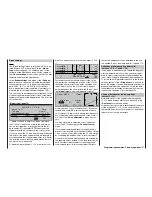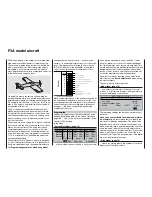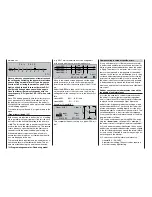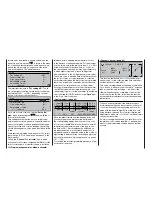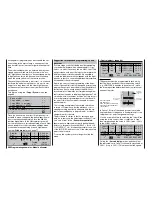
195
Programming examples: Fixed-wing model
b) Correction around the longitudinal axis (aileron)
LinearMix
4:
“RU
AI”
Asymmetrical setting. The exact values required
must be found by fl ight testing.
In most cases relatively small mixer values are called
for, typically below 10%, but this does vary from mo-
del to model. If you use curve mixers, the mixer ratios
can be adjusted even more accurately to match diffe-
rent rudder defl ections. Again, no defi nite values can
be stated, as they vary for each model.
Vertical climb and descent
Many models exhibit a tendency to deviate from the
ideal line in vertical climbs and descents.
To correct this we need an elevator centre position
which varies according to the throttle setting. For ex-
ample, if the model tends to pull out of a vertical de-
scent by itself when the motor is throttled back, slight
down-elevator must be mixed in at this throttle setting.
This is accomplished by programming a free mixer
“C1
EL”. As a rule you will need to set mixer values
below 5%, but once again there is no substitute for
test-fl ying.
Rolling (movement around the longitudinal axis)
at idle
When you reduce the throttle setting, the model may
tend to roll slightly in one direction. Clearly an aileron
correction must be made.
However, it is much more elegant to let a free mixer
“C1
AI” correct this effect than to move the stick
each time.
The input values are usually very small (around 3%),
and the adjustment process should only be carried
out in calm weather. Often all you need to do is apply
the mixer in the control segment between half-thrott-
le and idle. To achieve this, program the mixer
ASY-
metrically.
Rolling when ailerons and fl aps are extended
If you fl y the landing approach with both ailerons de-
fl ected up, the model may show a tendency to roll
slightly due to minor variations in aileron servo travel
(or constructional inaccuracies). This manifests itself
as one wing tending to hang low on the landing ap-
proach. Once again, this fault can easily be corrected
using a mixer “C1
AI” to vary the compensation ac-
cording to the position of the ailerons / landing fl aps.
You must provide a means of switching the mixer on
and off using the same switch which controls the aile-
ron / landing fl ap function (see previous page), so that
the mixer only has any effect when the aileron / lan-
ding fl ap function is activated.
The appropriate value must be found by test-fl ying.
Summary
The settings described on this page are intended pri-
marily for the “expert fl yer” who needs an F3A aero-
batic model which fl ies with absolutely accurate, neu-
tral control response.
Please bear in mind that it takes tremendous effort,
time, sensitivity and expertise to refi ne the fl ying cha-
racteristics of a model to this extent. Some experts
continue the programming procedure even when they
are fl ying. It is not advisable to try this if you are just a
moderately advanced pilot making your fi rst attempt
with an F3A aerobatic model. You would be well ad-
vised to request help from an experienced pilot, and
carry out the above-mentioned fi ne-tuning adjust-
ments one by one, with the expert at your side, until
your aeroplane exhibits the neutral fl ying characteris-
tics which you desire. At this point, when your model
is fl ying perfectly, you can forget all about trimming
and start concentrating on fl ying the aerobatic mano-
euvres themselves, which are not necessarily easy to
fl y well.
Summary of Contents for mx-24s
Page 1: ...1...
Page 19: ...19 For your notes...
Page 35: ...35 For your notes...
Page 41: ...41 41 For your notes...
Page 57: ...57 For your notes...
Page 63: ...63 63 For your notes...
Page 69: ...69 69 For your notes...
Page 85: ...85 85 For your notes...
Page 99: ...99 For your notes...
Page 143: ...143 For your notes...
Page 191: ...191 For your notes...
Page 212: ...212 212 For your notes...
Page 213: ...213 213 For your notes...
Page 214: ...214 For your notes...
Page 216: ...216...







